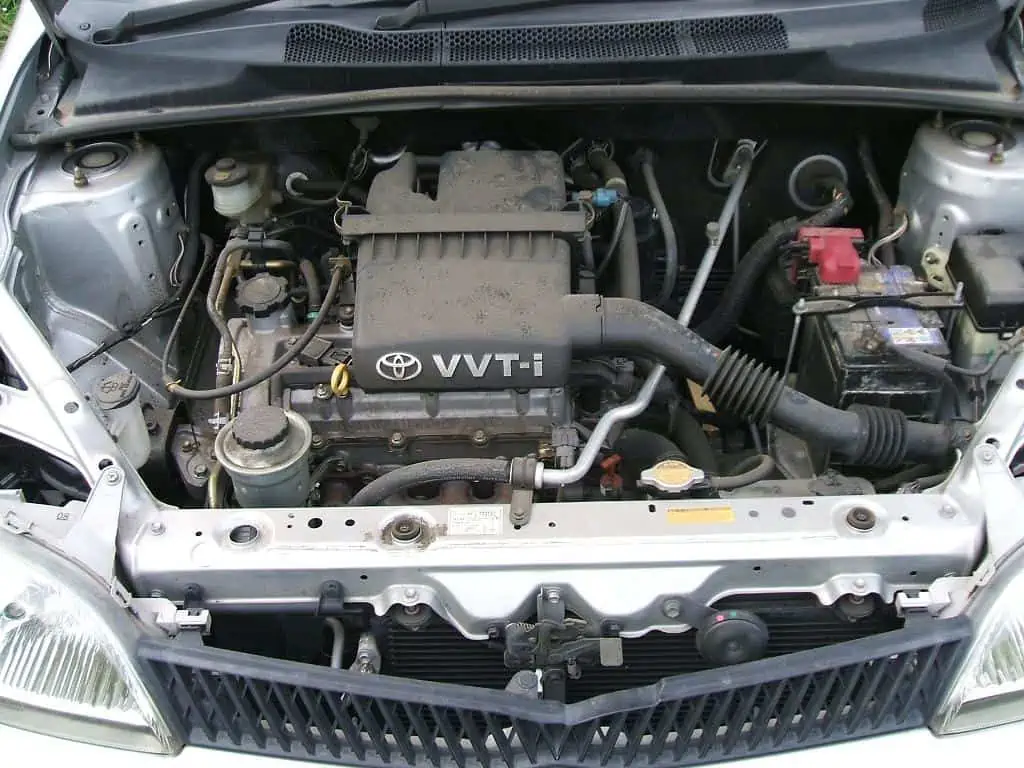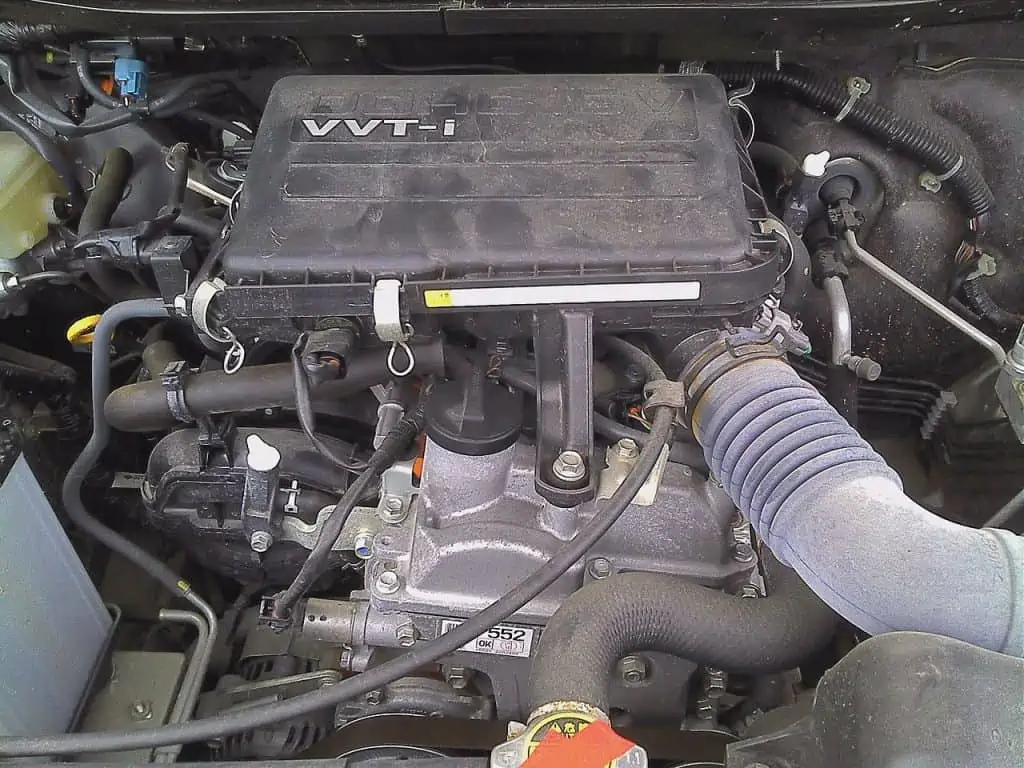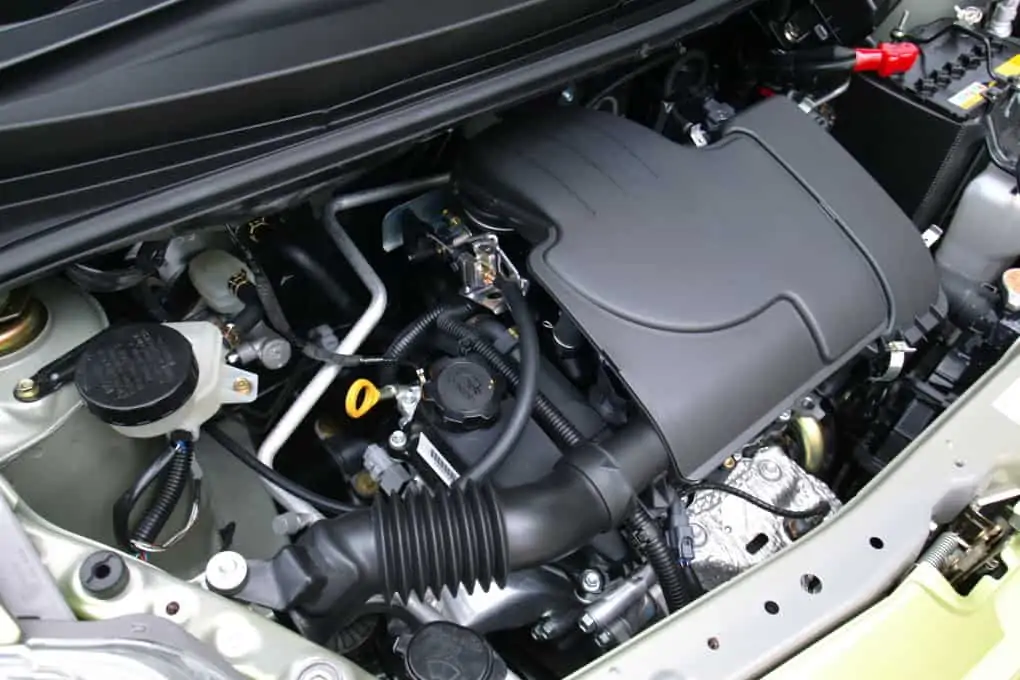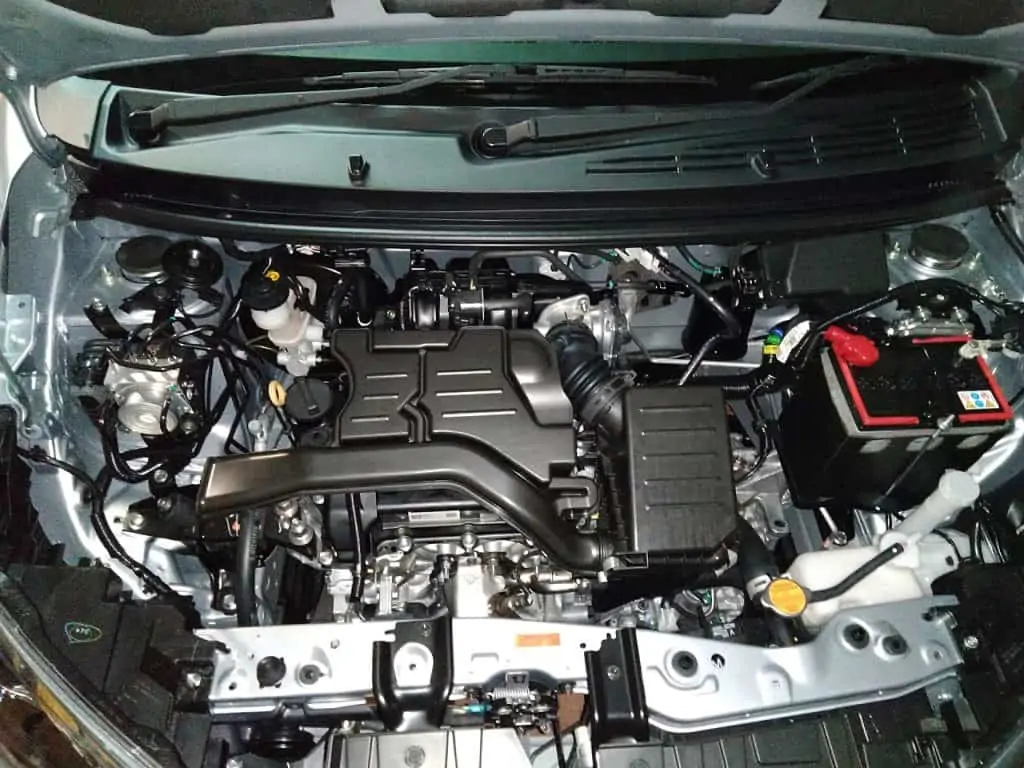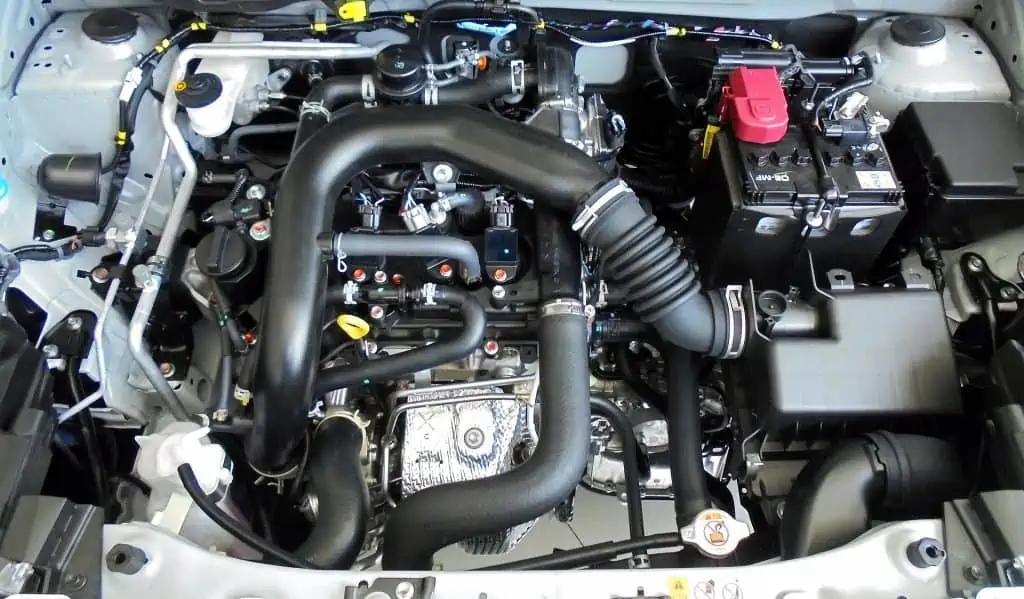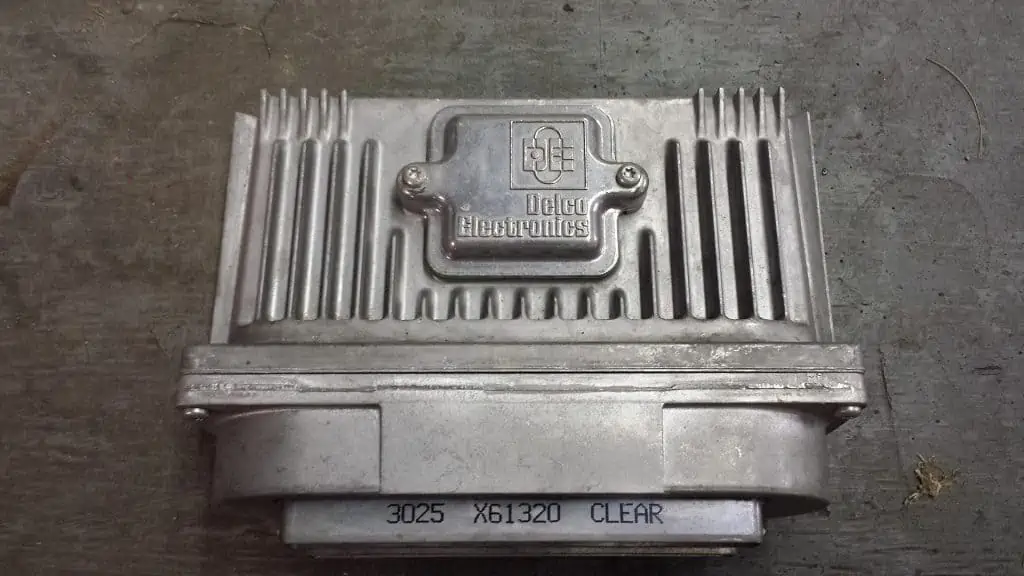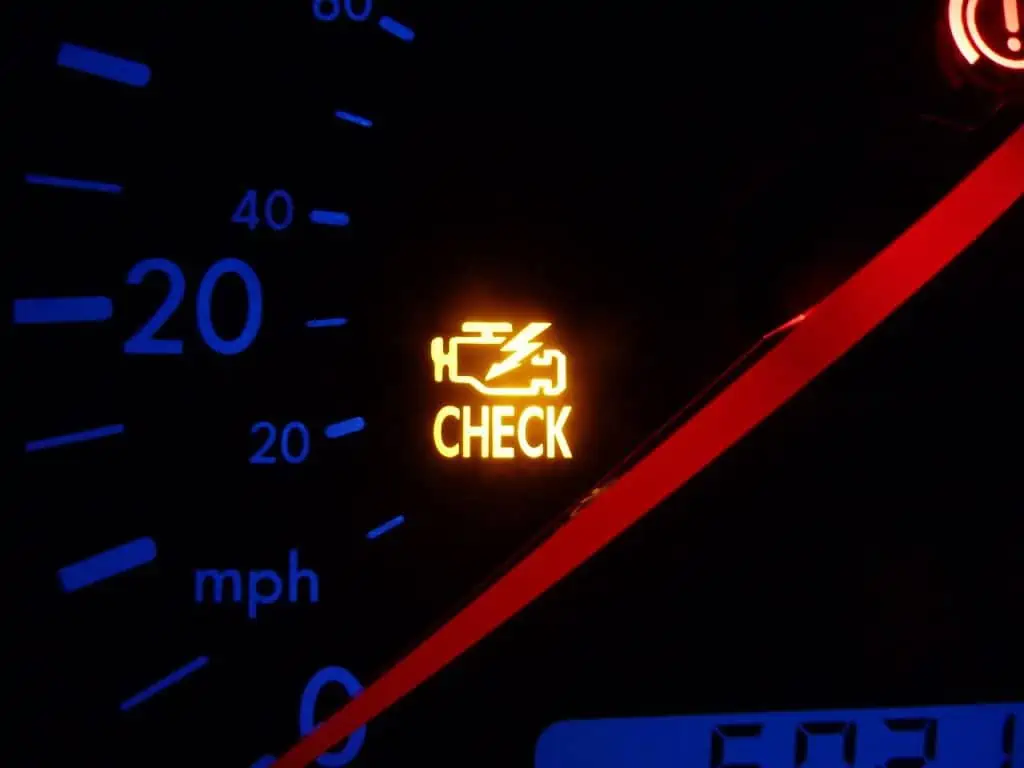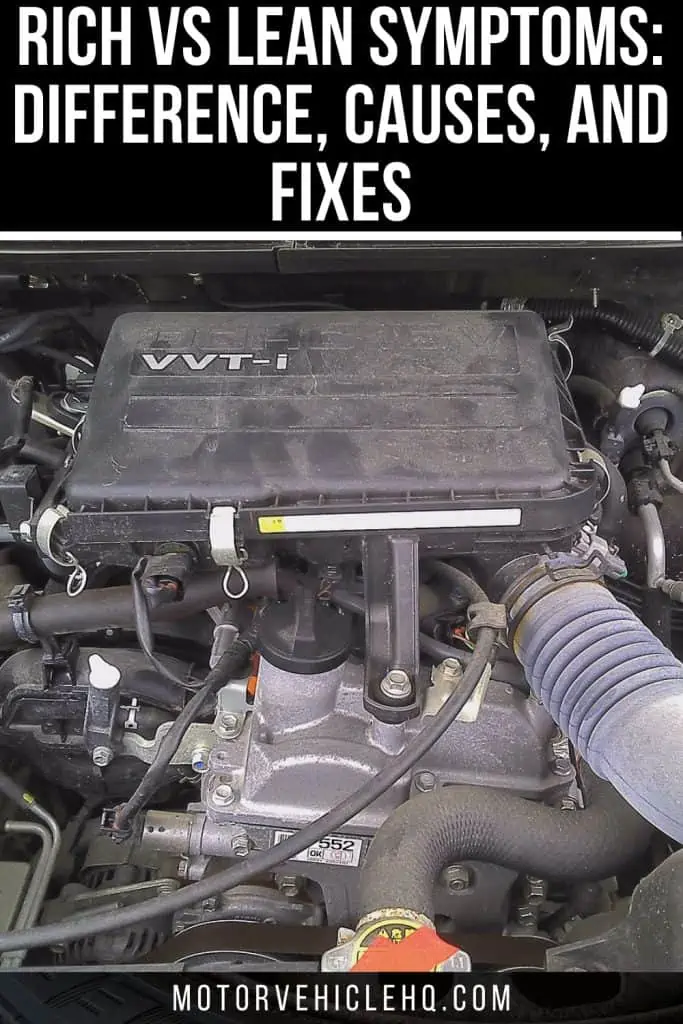If you want your engine to run at its best, you need to keep a careful balance. This implies that when your engine is running, you should monitor your lean-to-rich ratio. The air-fuel ratio in a motor vehicle engine must be 14.7:1 for a successful combustion process to take place. The air component is 14.7, while the fuel component is 1.
The engine will start running rich when the gasoline part is higher than the air portion. On the other hand, the engine will start running lean if the fuel portion is lower than the needed portion, which indicates that not enough gasoline is going through.
This article will describe the reasons, signs, and consequences of an engine running lean or rich, as well as how to rectify it. Several elements guarantee a proper fuel-to-air ratio. For instance, maintaining a proper air-fuel ratio is essentially the responsibility of the engine control unit (ECU) in every vehicle.
To keep the engine from running low or rich, fuel injectors, MAP sensors, MAF sensors, oxygen sensors, and emission sensors all contribute to a proper mixture ratio.
Running Rich vs Running Lean: What are the Differences?
It can be intimidating for a beginner or inexperienced at-home mechanic to understand all the technical words used while diagnosing an engine, whether it be on a car or a motorbike. However, don’t give up.
Everyone has a beginning. Today, we’ll examine the distinctions between running rich and running lean, as well as how you may look for these issues in your project.
As I stated earlier, the terms rich and lean refer to how much fuel the engine is using. There may be sensors on contemporary automobiles and motorbikes that illuminate to indicate that an engine problem is caused by operating too lean or too rich.
Running lean is the reverse of running rich, which occurs when there is too little air in the engine compared to the amount of fuel. But upon what are these figures based? What is too much fuel in comparison to?
Toyota 1SZ-FE engine for Toyota Platz by Carolla / CC BY-SA 3.0. When the gasoline portion is higher than the air portion, the engine will begin to run rich. On the other hand, if the fuel portion is lower than the required portion, which shows that insufficient gasoline is flowing through, the engine will begin to run lean.
The stoichiometric ratio is essential for engine combustion. Accordingly, there should be 14.7 parts air to 1 part fuel for optimal combustion. That means that a specific mixture of gasoline and air is required for the engine to produce power.
The amount of fuel and air in a particular combustion cycle can currently be detected in many different ways by engines, but it wasn’t always so simple.
Some of you out there probably own motorcycles with carbureted gasoline systems. For motorbikes, it was the accepted practice until a few decades ago. Today, fuel injection systems using injectors and gasoline pumps are common.
The air-fuel ratio was created in the carburetor before entering the cylinder when using a carburetor. This was excellent since it provided the engine with a thoroughly blended mixture for combustion, but the system as a whole was very ineffective. It lacked a direct measurement system for the fuel and air injected into the engine.
The so-called petcock valves would have needed to be changed if you wished to alter the ratio. Consistent though a carburetor is a very straightforward device, they frequently struggle to maintain a nice, even air-fuel ratio.
Motorcycles and automobiles can now precisely measure the amount of gasoline and air injected into the engine and analyze the exhaust vapor thanks to increasingly sophisticated injection systems.
These systems allow the amount of fuel injected to be adjusted per the volume of air entering the intake. Both motorcycles and cars may now be made more powerful and efficient thanks to these more recent technologies.
Your engine is running lean if, according to the stochiometric ratio, there is too much air in the cylinder, which means that the proportion of air to fuel is higher.
Your engine is running rich if there is more than one fuel component for every 14.7 air components. Both scenarios will result in distinct issues, therefore none is ideal.
What are the Main Causes of Lean Engine Conditions?
Finding the causes is essential, even though diagnosing a lean engine may be more difficult than a rich engine. An engine running lean can be caused by several issues. The most typical causes are listed below.
1. Obstructed Fuel Filter
All the nasty work is handled by your gasoline filter. The fuel filter makes sure that none of the debris, grime, or other impurities that enter your fuel tank makes it into the engine. All the debris and dirt begin to accumulate over time, obstructing proper fuel passage.
The gasoline filter element keeps dirt from passing through, but with time the debris and whatever else it is filtering out will clog the fuel filter. For this reason, it is advised that you frequently replace your gasoline filter.
2. Obstructed Fuel Injectors
To stop dirt from entering the fuel injectors, you should also clean the fuel filter. Small dirt and grime, as opposed to large dirt and grime that can clog fuel filters, can harm gasoline injectors.
The car engine is mounted on the chassis by Yones / CC BY-SA 3.0. Maintaining a careful balance is necessary if you want your engine to perform at its peak. This suggests that you should keep an eye on your lean-to-rich ratio while your engine is running. For a motor vehicle engine to successfully conduct combustion, the air-fuel ratio must be 14.7:1. 14.7 is the air component, while 1 is the fuel component.
Once obstructed, they won’t let the right amount of air and fuel into the combustion chamber. Cleaning them might not be enough in some circumstances; you’ll need to replace them.
3. A Bad Fuel Pump
Problems with low or rich engines begin at the fuel pump. Running lean indicates that not enough fuel is reaching the combustion chamber; fuel travels via the fuel pump before reaching the combustion chamber.
Poor or blocked fuel pumps won’t be able to export the necessary amount of fuel from the tank, which will result in low fuel pressure and possibly lean engine operation.
Unfortunately, if you don’t have the necessary tools, it might be challenging to replace a bad fuel pump in some automobiles. Even though it is frequently the cause of insufficient fuel supply, you don’t want it to be the culprit because replacing it might cost you between $350 and $600.
4. Obstructed Strainer
Two things could lead to this. There will be a pressure leak if the strainer extends into the space where the fuel pump fits. The strainer will not allow enough gas to pass through if it becomes clogged, which is the second method.
5. Leaks In the Fuel Lines
Gas is pressured-exported from the fuel pump. Fuel pressure will be lost if there is a fuel leak along the lines. The engine runs low as a result of fuel line leaks. Additionally, it will lead to a fire outbreak that can cause fatalities.
6. A Leaking Vacuum System
Fuel loss issues might result from vacuum leaks. Unmeasured air entering the system and causing an uneven air-fuel combination is one of the issues.
7. Ineffective Fuel Pressure Regulator
Lean problems are brought on by a poor fuel pressure regulator. Fuel pressure may decrease as a result of a defective regulator leaking fuel.
8. Bad Oxygen Sensors
Modern cars employ sensors to manage a lot of the outputs, thus if your oxygen sensor is broken, your engine can run low.
The oxygen sensor instructs the engine control unit (ECU) of your car how much fuel to add to each cylinder. The engine control unit will therefore be instructed to provide less fuel to the combustion chambers when the oxygen sensor malfunctions because it will start reporting excessive false emissions.
No matter how little fuel is sent, the poor oxygen sensor will continue to alert the driver to high emissions.
I have some news for you. When the engine is running lean, you should always assume this is the source because it’s inexpensive and simple to fix.
A Toyota 1KR-FE engine by Tennen-Gas / CC BY-SA 3.0. Your car’s engine control unit (ECU) receives instructions from the oxygen sensor on how much fuel to add to each cylinder. Because the oxygen sensor will start reporting too many false emissions when it malfunctions, the engine management unit will be told to add less fuel to the combustion chambers.
Rich vs Lean Symptoms: Engine Running Lean Symptoms
You may detect when the engine is running rich or lean by being aware of the indications of lean vs. rich engine operation. How can you tell whether your engine is operating lean?
A lean-running engine can exhibit several symptoms, just like any other automobile issue. The following symptoms are ones you should be on the lookout for to prevent serious engine damage.
1. Low Power Output and Subpar Performance
Even if you manage to start your automobile with a lean engine, the performance and power output will be poor. The rationale is that optimizing engine performance necessitates more fuel input than what the fuel injectors can supply at random.
To enhance performance and power, each fuel injector must separately spray an excessive amount of fuel into the cylinder chambers.
Poor acceleration is a sign that the engine is running low. Why is it the case? A gas explosion generates the necessary force to push the piston down and up whether you’re operating a petrol or diesel engine.
The Piston is pushed upward by the explosion force, which also generates the necessary power to keep your engine going. A smaller explosion brought on by insufficient fuel will result in slower-moving pistons.
2. The Car Won’t Start
The engine of your car needs fuel to start. You won’t be able to start the automobile without it. Your engine may not start due to insufficient fuel entering the combustion chamber for a variety of reasons. Hard starting is consequently one of the symptoms of a lean engine.
3. Clean or White Spark Plugs
Things become dirty when everything is functioning at its best. You probably have a problem if you take out your spark plugs and they appear to be white or brand-new. Spark plugs that are dusty are frequently thought to be malfunctioning, although it’s not always the case.
Fuel must burn for a combustion process to occur, and the burning fuel must leave some residue on the spark plugs. As the spark plug remains in place longer, the leftovers increase.
4. The Check Engine Light Comes On
Modern automobiles contain a huge number of sensors. The moment they detect a problem, they send a signal to the ECU, which then turns on the check engine light to let you know there is a problem that needs to be fixed.
When diagnosed, it won’t, however, indicate that the engine is running low. It will instead identify the root cause. The check engine light could come on if your oxygen sensor is bad or your fuel pressure is low. In either case, a diagnosis will reveal the true problem.
5. Frequent Engine Stalls
Even if you can start the engine, you might have trouble keeping it running, which is one of the typical indications of an engine running lean. Sometimes it will sputter and jerk unceasingly until it stops moving or you fix it.
A car’s engine by Shmee150 / CC BY-SA 4.0. Your car’s engine needs fuel to start. Without it, you won’t be able to start the car. For a variety of reasons, your engine might not start because not enough fuel is getting into the combustion chamber. As a result, one of the signs of a lean engine is hard starting.
The car will continue to run easily when you export additional gas into the system by accelerating. You won’t receive the desired power output, though.
What are the Constraints of a Lean Fuel Mixture?
Lean engine operation affects more than just gas usage. Higher friction is produced on an engine’s moving parts when it runs on less gas than it needs. Typically in 2-stroke engines, an engine operating lean has an improper air-fuel combination.
You might be curious about lean vs. rich two strokes. Lean engine operation has more negative impacts on two-stroke engines. Let’s quickly review the consequences of running the engine lean.
1. A Hard Seizure
A hard seizure occurs when the engine runs lean, which causes the chambers and pistons to heat up more than the engine can handle. If you don’t repair this problem, the pistons may normally rub against the cylinder walls.
Both the crankshaft arm and the cod rod have the potential to break or bend. The outcome is disastrous, necessitating the replacement or rebuilding of the engine.
2. A Soft Seize
The term “soft seize” refers to the severe damage brought on by friction between the pistons and cylinder walls of an engine. Where the moving parts of the engine rub against one another over time, a dry area forms.
The cylinder walls and pistons may become burned or scratched as a result of this rubbing. If you correct it and the usual air-fuel ratio returns, the cylinder and pistons will still be damaged but they will still function properly.
3. The Engine Cuts Off
The combustion process won’t occur if the engine’s fuel injection systems don’t provide fuel to the combustion chamber; as a result, the car engine won’t start. The engine will function at its best once the root cause of this is resolved.
How Can I Fix Lean Fuel Mixture Symptoms In My Car?
As a result of your knowledge of the signs and causes of a lean engine, correcting a lean fuel mixture effect won’t be a pain in the behind. To be clear, an engine running lean is a problem and a sign of another issue. Having said that, addressing the root cause of the issue is necessary to remedy an engine that is running lean.
1. Fixing Leaks In the Vacuum System
A lean fuel mixture may result from vacuum leaks. Lean issues can be resolved by inspecting and replacing faulty vacuum lines with good hoses and clamps.
2. Fixing Obstructed Fuel Filters
The amount of fuel that the engine needs will be restricted by blocked fuel filters. You should check your gasoline filter if your engine is running lean and replace it if necessary.
A setup of the engine bay by オーバードライブ83 / CC BY-SA 4.0. The performance and power output of your car will be subpar even if you can start it with a lean engine. The argument goes that to maximize engine performance, more fuel input is required than what the fuel injectors can deliver at random.
3. Frequently Examining the Fuel Lines
You should inspect your gasoline lines for leaks and patch them up if you find any. The gas tank may be home to fuel leaks. If you have previously worked on the gasoline tank, you must check the fuel hose within.
4. Fixing an Ineffective Gasoline Pump or Obstructed Strainer
If the fuel pump pressure is low, you must analyze the problem and replace the damaged fuel pump and blocked strainer.
5. Examining and Replacing the Defective Oxygen Sensors
To ensure that the ECU receives accurate information about what’s happening in the exhaust system, you must diagnose and replace any defective oxygen sensors.
6. Fixing the Dirty or Obstructed Fuel Injectors
You need to identify any clogged fuel injectors and replace them because that is one of the potential causes of an engine running lean.
What are the Main Causes of Rich Engine Conditions?
There are causes for every problem, just like there are for any other issue with an automotive engine. After that, let’s consider the potential reasons why Rich’s automobile might be operating.
1. Faulty Oxygen Sensors
Oxygen sensors keep an eye on and control the exhaust pipe’s air-fuel ratio. The ECU receives the information and instructs the fuel injectors to modify the amount of fuel entering the combustion chamber. The engine control unit will receive erroneous readings when the oxygen sensor malfunctions.
2. A Malfunctioning Engine Control Unit (ECU)
The engine control unit is in charge of managing the combustion chamber’s air-fuel mixture ratio. If the ECU develops a problem, the fuel injectors will get erroneous information from the ECU. The fuel injectors can receive a signal to sputter too much fuel into the combustion chambers.
3. Defective MAF Sensor
The MAF sensor is in charge of regulating the amount of air needed to burn a specific amount of fuel. Your car’s computer will receive inaccurate indications from a damaged MAF sensor, which will result in an incorrect air-fuel mixture ratio and an overly rich engine.
4. Obstructed Air Filter
Poor engine efficiency and excess unburned gasoline will come from a blocked cold air intake or air filter, which prevents the necessary amount of air from reaching the engine.
5. Bad MAP Sensor
The MAP sensor is in charge of signaling the vehicle computer and indicating the pressure in the intake manifold. When the MAP sensor malfunctions, it will give incorrect readings, which will cause the mixture to be rich.
An engine control unit (ECU) by Mgiardina09 / CC BY-SA 3.0. The air-fuel mixture ratio in the combustion chamber is controlled by the engine control unit. If the ECU has a fault, incorrect information will be sent to the fuel injectors via the ECU. An instruction to spit too much gasoline into the combustion chambers can be sent to the fuel injectors.
6. Defective Fuel Injectors
Due to malfunctioning fuel injectors, your car’s engine won’t obtain enough air-fuel combinations. Unburned gas ends up in the exhaust system as a result.
7. Malfunctioning Coolant Temperature Sensor
The coolant temperature sensor measures engine temperature and communicates that information to the vehicle’s computer. An engine will run rich if a poor coolant temperature sensor sends a false report.
Lean vs Rich Symptoms: Engine Running Rich Symptoms
You need to be aware of the indications of an engine running rich if you want to keep your car’s engine from suffering its repercussions.
1. The Check Engine Light Illuminates
Any time a warning light appears on your dashboard, your engine is experiencing trouble. Since there are numerous potential causes for this light to be on, you should diagnose your car to determine why it is on. You want to use a contemporary scan tool to diagnose your engine. Error code P0172 indicates that there is too much-unburned gas in the exhaust pipe.
2. Bad Odor
A strong stench of rotten eggs coming from your exhaust pipe is one of the typical signs of a rich engine. There is too much-unburned gas in the exhaust pipe, which is the source of this terrible odor. If the air-fuel ratio is extremely rich, the catalytic won’t completely burn the unburned gas even though it is burning fumes.
3. Engine Performance Problems
Let’s say you notice poor engine performance; this points to several issues, such as a lean or rich spark plug, an inefficient combustion chamber, or an improper air-fuel ratio. If the compression and spark plugs are working properly, then an insufficient air-fuel combination is unquestionably the issue.
4. Erratic Engine Idling
Engine vibrations and stalling could be caused by an inefficient air-fuel combination. An engine running richly is indicated by rough idling.
5. Poor Gas Mileage
Your engine is running rich if you consistently receive lower fuel economy from your car. This suggests that more fuel is being burned by your engine. Nevertheless, you must admit that less mileage is typical during the winter months.
6. More Emissions of Carbon Monoxide
The powerful engine could emit a lot of carbon monoxide. Additionally, it won’t pass the state emission test. Carbon monoxide is hazardous to humans because it has both physical and mental side effects.
7. Faulty Spark Plugs
The lower edge of the spark plugs will have carbon buildup while your engine is running rich, which will result in poor engine performance. It’s a sign that there is unburned fuel in the exhaust system.
What are the Constraints of a Rich Fuel Mixture?
Rich engine operation will have several negative consequences on the engine’s performance and durability. Low gas mileage, shaky driving, decreased engine efficiency, poor acceleration, and a loud gas smell are a few consequences that will follow.
A check engine light or malfunction indicator lamp (MIL) by Wikiuser100000 / CC BY-SA 3.0. Your engine is having issues any time a warning light flashes on the dashboard. You should examine your vehicle to find out why this light is on because there are various probable causes for it to be on. To diagnose your engine, you need to employ a modern scan tool. The exhaust pipe has too much-unburned gas, according to error code P0172.
However, these effects can be a sign of more serious problems developing in the combustion chamber. You should keep an eye out for the highlighted Symptoms of a rich engine to avoid the risks connected with one.
Your engine’s performance and lifespan depend on receiving the proper air-fuel ratio mixture. To address the root of the problem promptly, you must be alert for a lean vs. rich engine.
How Can I Fix Rich Air Mixture Symptoms In My Car?
Knowing the signs, causes, and consequences of a rich air mixture may make you curious about how to deal with one. In the paragraphs that follow, you will learn how.
1. Examine the Air Duct Flap
Inside the duct is a flap that serves as an open and shut valve. As the engine warms up, it progressively opens fully after opening halfway at start-up. If it’s not working properly, you need to diagnose it and replace it.
2. Check Vacuum Lines and Dangling Pipes
Your engine may run rich due to damaged water hoses and lost vacuum lines. A hissing noise can be used to detect air leaks. To increase the efficiency of your engine, you must address the air leak as soon as you identify its source.
3. Clean or Replace the MAF Sensors
A poor MAF sensor will deliver a false report to the ECU, which will cause the engine to perform poorly. Remove the screw and thoroughly clean it. If you’re unsure about cleaning it yourself, you can consult your owner’s manual for advice. Reinstall it using the opposite procedure after cleaning.
4. Replace Damaged Oxygen Sensors
You should identify and replace your 02 sensors if your vacuum lines, air duct flap, and MAF sensor are all working properly but your engine is still running rich.
5. Replace the Worn Spark Plugs
Too much-unburned gas will enter the exhaust pipe if the spark plugs are unable to generate enough spark.
Failure to change the spark plugs will result in an overabundance of unburned gas being continuously released into the engine.
Lean vs Rich Symptoms: Can They Harm the Engine?
The damage will happen if you operate a motorcycle, automobile, or other engines outside of the stoichiometric ratio for an extended period. The excess heat in the engine could warp a head gasket or damage an exhaust, or it could cause your spark plugs to prematurely wear out.
It’s critical to monitor the performance of your engine so that, if something goes wrong, you can identify it before it results in long-term harm. The fuel mixture in your engine will never be exactly 14.7:1, but by making sure the carbs are tuned and the fuel pump is working, you can keep it in good shape for many years and many miles to come.
The Conclusion
If your car’s engine is essential to its operation and enjoyment, you must keep it in good shape. The best method to ensure the longevity and functionality of your engine is to have it regularly inspected and maintained as soon as you discover a problem. Understanding the differences between lean and rich can enable you to detect problems with your combustion chamber.
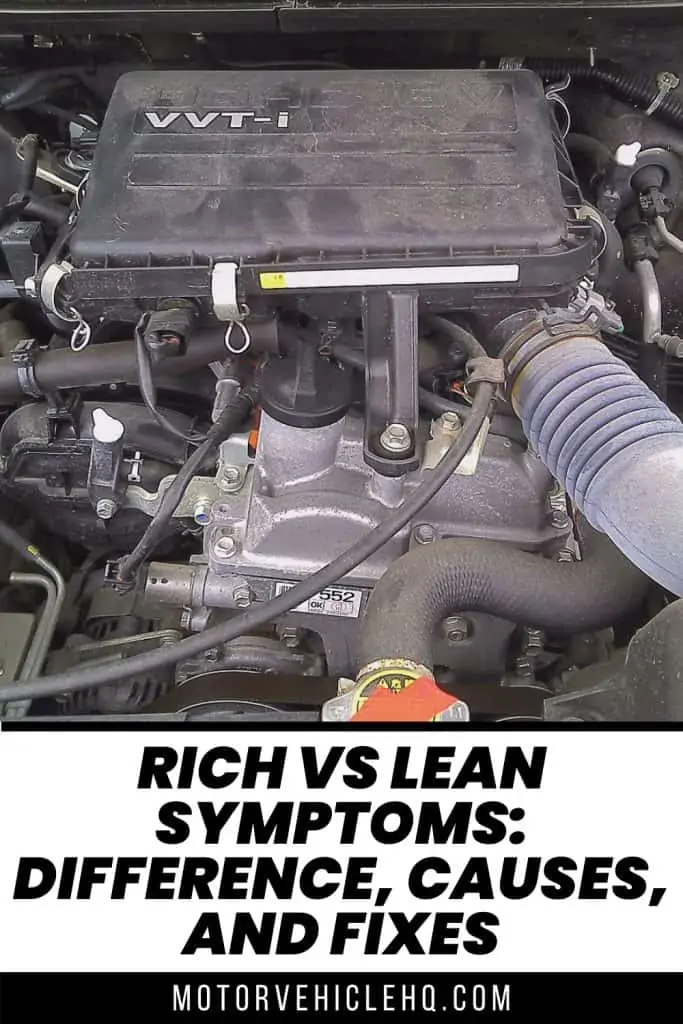
The car engine mounted on the chassis by Yones / CC BY-SA 3.0

Jim Wicks is the founder of MotorVehicleHQ. With over two decades of experience in the automotive industry and a degree in Automotive Technology, Jim is a certified car expert who has worked in various roles ranging from a mechanic, car dealership manager, to a racing car driver. He has owned more than 20 cars over the past 15 years. Ask him about any vehicle you see on the road and he can tell you the make, model and year. He loves the aesthetics of all things cars, and keeps his vehicles in pristine condition.
In his free time, Jim enjoys getting his hands dirty under the hood of a classic car or taking long drives along the country roads. His favorite car? A 1967 Shelby GT500, a true classic that, according to Jim, “represents the pure essence of American muscle.”
